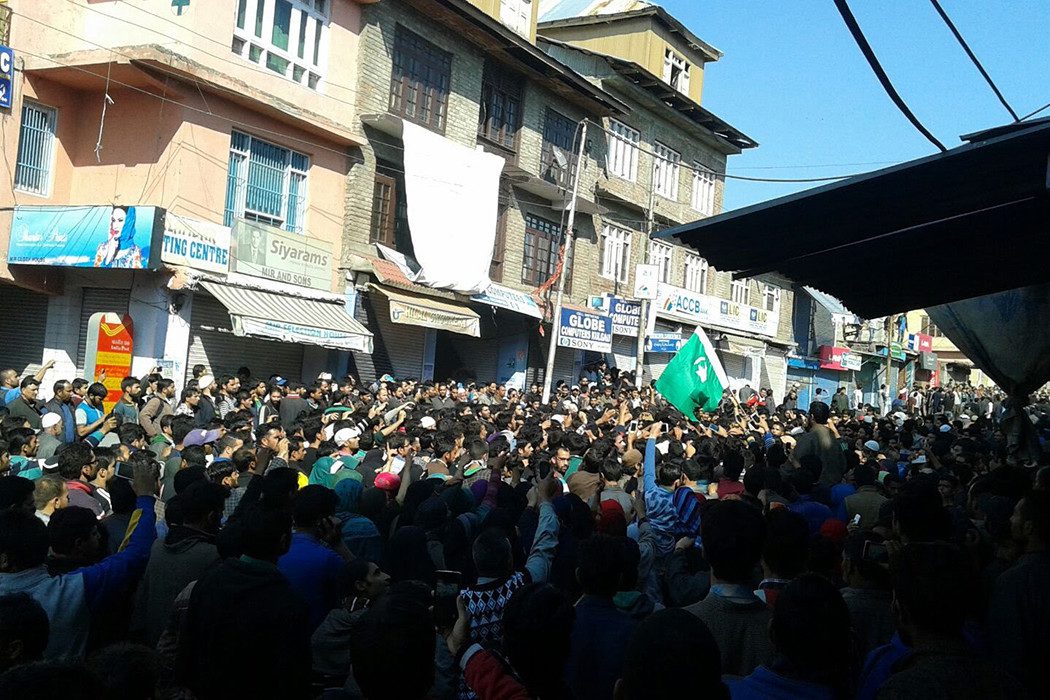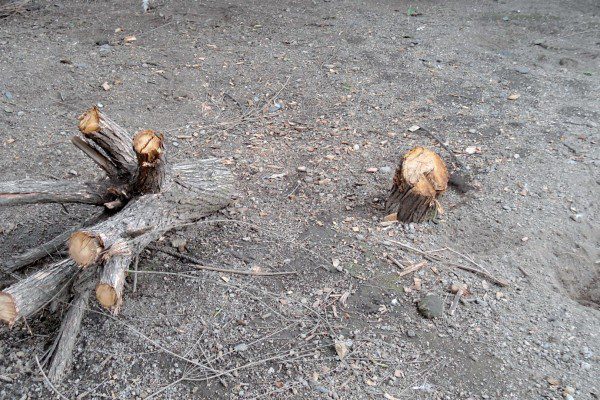Decades of betrayals and a refusal to treat Kashmir as a political issue is driving a new generation to take up arms, reports Shujaat Bukhari.
Kashmir is again on the edge. The ground reality is marked by unease and frustration. For over 25 years, the place is confronting a conflict that has emanated from continuous denial of resolving the political dispute. As New Delhi refuses to shun its stubbornness vis-à-vis the approach with which it has dealt with Kashmir since 1947, a new phase of despondency and frustration has crept in, particularly among the youth. The result is a political volcano that threatens to explode in any direction at any time.For nearly seven decades now, Kashmir has been searching for a dignified solution. Its conditional accession to the Indian Union in 1947 has left open a space for discontent and disillusionment. The average Kashmiri not only feels betrayed over the first promise of a plebiscite made by Jawaharlal Nehru, but also the subsequent machinations of eroding the special status that the state of Jammu and Kashmir enjoyed within the union of India. Continuous efforts to weaken Article 370, which guarantees the special status, and the toppling of elected governments further widened the gulf between Srinagar and Delhi. On many occasions, Nehru reiterated his promise of resolving the issue as per the aspirations of the people. For example, on 2 November 1948, he said in a broadcast:
We have declared that the fate of Kashmir is ultimately to be decided by the people. That pledge we have given, and the Maharaja has supported it, not only to the people of Kashmir but also to the world. We will not, and cannot back out of it. We are prepared when peace and law and order have been established to have a referendum held under international auspices like the United Nations. We want it to be a fair and just reference to the people, and we shall accept their verdict. I can imagine no fairer and just offer.
Not only did he back out from this promise, however, he also ensured that the state remained politically disempowered. He even ditched his “best friend” Sheikh Mohammed Abdullah, who helped India get Jammu and Kashmir into its fold. Sheikh Abdullah was dismissed as Prime Minister of the state and arrested on 9 August 1953, because he had realised his “mistake” and was now talking about the restoration of political rights of the people.
The average Kashmiri not only feels betrayed over the first promise of a plebiscite made by Jawaharlal Nehru, but also the subsequent machinations of eroding the special status that the state of Jammu and Kashmir enjoyed within the union of India.
The arrest was soon followed by the sham exercise of “managed” elections and thrusting puppets onto the state along with a heavy dose of economic packages. Sheikh Abdullah remained outside mainstream politics for 22 years, until he reached an agreement that shaped the Indira-Abdullah Accord in 1975. But the plan to erode the autonomy the state enjoyed until 1953—by bringing central laws into force; extending the jurisdiction of the Supreme Court, the Election Commission and the Comptroller and Auditor General; and changing official nomenclature from Prime Minister to Chief Minister and Sadr-e-Riyasat to Governor, to ensure Jammu and Kashmir was like any other state—was already being executed.
The state that had acceded to the Indian Union through the actions of its Hindu ruler felt cheated at every step. Notwithstanding the people taking part in the elections, their mandate was hardly honoured, with mass rejection of the nominations of opposition parties. Although political disenchantment continued to brew under the surface, the people of the state, particularly Kashmiris, did not lose faith in the democratic exercise. However, the wholesale rigging of the 1987 assembly elections by Delhi was the final straw.
In 1987, the newly created Muslim United Front (MUF) was pitted against the ruling National Conference-Congress combine. The popular perception was that the MUF would net a majority of seats in the Valley. But thanks to systematic rigging by Farooq Abdullah’s government with the active support of Rajiv Gandhi, only four out of 43 MUF candidates, including hardline separatist Syed Ali Shah Geelani, won the elections. The “organised defeat” of the rest laid the foundation for dark times to come. Some of them would later assume leadership roles in the armed insurrection that broke out less than two years later.
Mohammad Yusuf Shah, for instance, contested from Amira Kadal, a neighbourhood of Srinagar. Although early counts suggested he would win by a landslide, the NC’s Ghulam Mohiuddin Shah was declared the winner amid allegations of rigging and booth capturing. Yusuf Shah would go on to become the supreme commander of the Hizb-ul-Mujahideen, using the nom de guerre Syed Salahuddin. In a 2011 interview, he told me that by rigging the elections, “New Delhi performed the last rites of democracy in Kashmir. Farooq Abdullah himself came to a polling booth in Sarai Bala and threw ballot boxes out of the window. Even Mohiuddin Shah’s family members voted for me. But I was arrested and sent to Hira Nagar jail. JKLF chief Yasin Malik and others were working for me. They were also tortured and sent to jail.”
The floodgates were thrown open in late 1989, with thousands of youth crossing over to Pakistan and Pakistan-administered Kashmir to join the militant ranks. The mayhem soon followed, and Kashmir went through the most difficult times in its history. Unnerved by the new reality in Kashmir, New Delhi did send overtures to attempt damage control—Chandra Shekhar’s olive branch to the militants, to PV Narsimha Rao’s famous expression that the “sky is the limit” when it comes to restoring autonomy, to Deve Gowda and Gujral’s reiteration that the wrongs of history would be undone, to Vajpayee’s assertion that dialogue would be held within the limits of “insaniyat” (humanity).
The “organised defeat” of the rest laid the foundation for dark times to come. Some of them would later assume leadership roles in the armed insurrection that broke out less than two years later.
From 2003 to 2008, when India and Pakistan seemed to be inching towards peace, Kashmir was mute but supportive of all the initiatives. Confidence building measures across the Line of Control, like a bus service and trade, renewed hope for a final resolution and the reunion of the state. Militancy declined by phenomenal levels. A major section of the separatists entered into dialogue with the Vajpayee government, and tourists returned to Kashmir, but the apparent return to normalcy convinced New Delhi that “nothing political needed to be done.”
Once the India-Pakistan bonhomie ended after the Mumbai attacks in 2008, hopes in Kashmir also faded. State governments continued to be elected with greater turnouts, but that had little impact on the psyche of the people, especially the youth. Unprecedented political unrest saw Kashmir seething with anger, claiming over 200 civilian lives in police action between 2008 and 2010. The Centre then played the joke of appointing interlocutors; the trio—Dileep Padgaonkar, Radha Kumar and MM Ansari—came, spoke and returned to draft a document that was disowned by the very home ministry that had appointed them in the first place.
The ultimate result of this string of betrayals is that Kashmir is back to square one, with political discontent touching new heights and the youth returning to militancy with popular support. The outlook of the militancy has changed in the last two years or so. After the setbacks of the mid-1990s, caused by rebellion within militant ranks and the birth of the pro-Army Ikhwan, who the separatists dismissed as “renegades”, the militant setup went into the hands of foreigners. Foreign militants, mostly Pakistanis, outnumbered Kashmiris four to one.
The Centre then played the joke of appointing interlocutors; the trio—Dileep Padgaonkar, Radha Kumar and MM Ansari—came, spoke and returned to draft a document that was disowned by the very home ministry that had appointed them in the first place.
This arrangement continued for a long time, but after the peace process was derailed, a vacuum was created. The hanging of Afzal Guru in 2013 caused the situation to degenerate, which further led to progressive despondency and frustration. Also, a narrative perceived as anti-Kashmir, built by a section of the Indian media and practised by the BJP government, contributed to the escalation of the situation—swords seemed to be out on issues such as Masarat Alam’s release, the beef controversy, and hoisting two flags.
Analysts also do not rule out the PDP’s decision to align with the BJP as a factor. The PDP has always been seen playing a middle role between the NC and the Hurriyat. The party sought votes on the promise of keeping the BJP out of power, and mobilised the youth in south Kashmir in that spirit. Officials confirm that some of the youth who actively supported the PDP as election agents joined militant ranks after the “unholy alliance” was stitched.
With no sign of intent on the part of New Delhi to approach Kashmir politically, a new window towards militancy and violence has been opened, precisely to the local youth. In the recent past, Burhan Wani, a handsome 21-year-old from south Kashmir’s Tral area, has become very popular on social media after releasing a series of videos. He is a top commander for the Hizbul Mujahideen, an indigenous militant group that has seen a resurgence of late in a scene dominated by the Lashkar-e-Toiba and Jaish-e-Muhammad. Official figures suggest that there has been a trend of Kashmiri youth, including some with college degrees, joining the militancy for some time now—28 locals joined in 2013, 60 in 2014, 66 in 2015 and 12 in the first two months of 2016, increasing Kashmiri representation in the militant ranks from 20 to 30 percent.
Officials confirm that some of the youth who actively supported the PDP as election agents joined militant ranks after the “unholy alliance” was stitched between the BJP and PDP.
As militants stepped up their strikes, it led to their killings. But the most significant change observed was the large participation of locals in their funerals. Two months ago, when Abu Qasim, an LeT commander, was killed in Kulgam district, his funeral was attended by over 30,000 people. (By contrast, only around 5,000 gathered at the funeral of Chief Minister Mufti Mohammad Sayeed.) Not only did the crowd gather in a short time, two villages even fought for custody of his body and the right to host the burial. Qasim, incidentally, was a Pakistani national. It was the fear of a similar situation that the prompted the police to quietly remove the bodies of three Pakistani militants killed in the encounter at Pampore on 22 February and bury them far away in Uri, near the Line of Control. People in the area had been aggressively asking for their bodies to be handed over to them.
How is it that despite the state being riddled with violence and people repeatedly talking about their fatigue and remorse over the loss of life and property, militants have become heroes again in Kashmir?
With the political status quo unlikely to change, the entry of the local youth seems to have attracted the people towards this “used method”. Not only have they become heroes, many believe that the new breed of Kashmiri militants is “harmless”. Unlike in the 1990s, today’s militants do not make the lives of commoners uncomfortable. They don’t indulge in local disputes or interfere in government functioning, nor do they resort to extortion. This might be a factor playing a reverse game, but the larger problem lies in New Delhi’s continuous refusal to recognise Kashmir as a political dispute and address it politically, thus leaving a free space for extremist tendencies, in which even the common people get involved.


